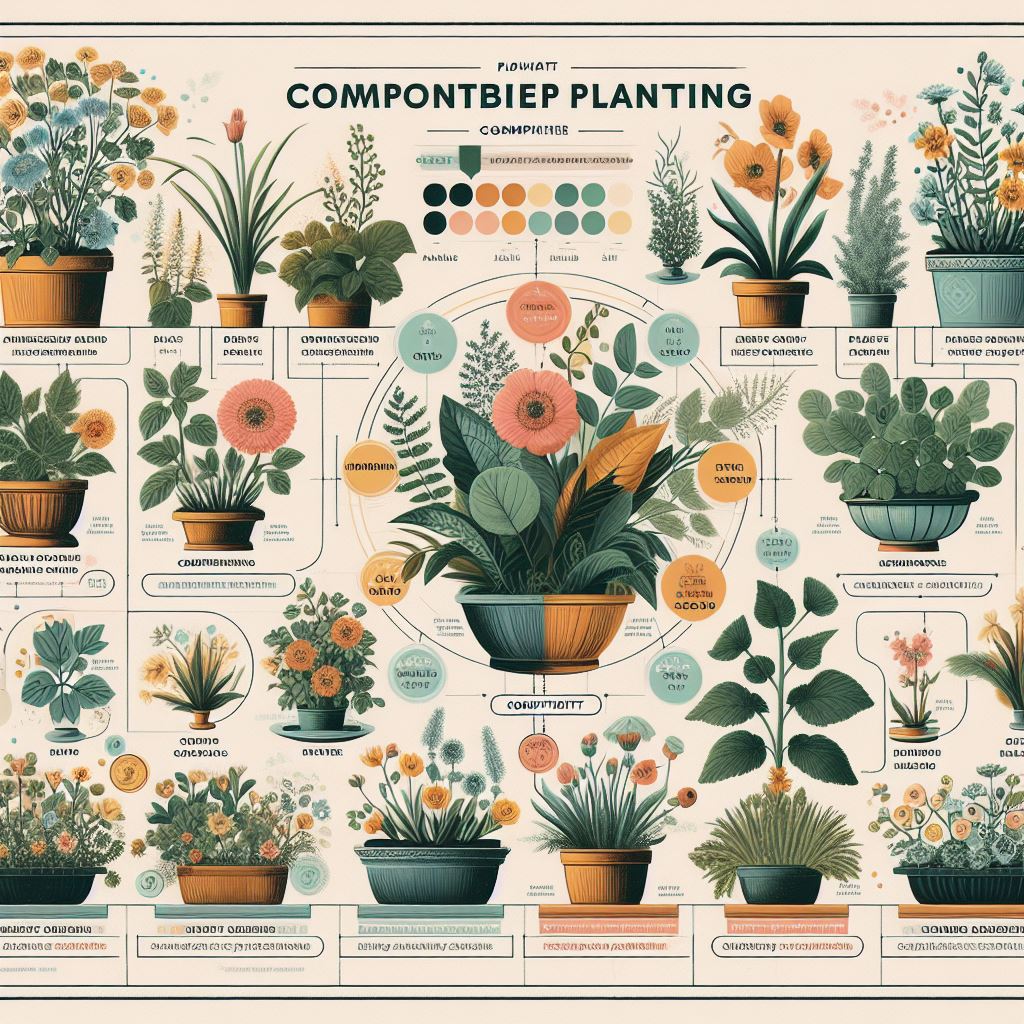
Are you itching to flex your green thumb but feel constrained by a small balcony or a petite patio? Don’t worry too much about the size of your space. Instead, let’s unlock the potential of companion planting to transform even the tiniest of areas into a flourishing garden. But what is companion planting? It’s a method of placing plants together that can benefit each other, either by deterring pests, improving soil nutrients, or providing shade.
Naturally, gardening in smaller spaces comes with its challenges. You may think there’s not enough room to grow anything worthwhile, but that’s not the case. There’s a lot of opportunity in confined garden spots if you strategize correctly. Not only can companion planting save space, but it also maximizes the use of available resources. This technique can allow plants to share the light, nutrients, and water available to them, making the most out of every square inch.
Setting realistic expectations is key when you’re planning a micro-garden. You’re not going to cultivate a farm’s worth of produce, but you will likely be able to enjoy fresh herbs, select vegetables, and beautiful flowers. It’s all about smart planning and making informed choices.
As we transition into section two, I’m going to help you with strategizing your small-space garden layout. You’re going to find out about assessing your available space, picking plant companions wisely, and how to leverage vertical gardening methods. These strategies will ensure that you get the most out of companion planting, no matter the size of your green patch.
Planning Your Companion Garden: Strategies and Considerations
I’m going to walk you through some effective strategies for planning your garden that make the most of every inch you have. Assessing your space is your starting point; pay attention to how much light it gets, what the soil is like, and how easily you can access it for maintenance. Remember, every spot has its microclimate, which can significantly influence what will thrive there.
You’re going to find out about choosing plants that live well together. This isn’t just about picking plants that look good side by side; it’s also about understanding their needs and behaviors. Some plants may need more sunlight while others require shade; some need lots of water, others not so much. It’s essential to select combinations based on size, growth patterns, and nutritional needs to ensure they don’t compete but rather complement each other.
Now, let’s talk about not just spreading out, but going up! Utilizing vertical space with trellises, hanging baskets, and wall planters allows you to grow more without needing more ground space. It’s perfect for climbing plants like peas, beans, and some types of squash.
Rotation and succession planting are your best friends in a limited area. Once a plant has finished its cycle, you can replace it with another that will benefit from the previous plant’s contribution to the soil. This system keeps your garden productive all season long. Don’t worry too much about getting this perfect on the first try. Gardening is a learning experience, and you can always adjust your approach down the road.
Popular Companion Planting Combinations for Small Gardens
If you want to make the most of your small garden, choosing the right plants to grow side by side is crucial. Companion planting isn’t just about saving space; it’s also about creating a flourishing ecosystem where plants support each other. I’m going to share some top-notch combinations that work wonders in limited areas.
Herbs and leafy greens often become the best of friends in a tiny garden plot. Think about pairing basil with spinach or cilantro with lettuce. The herbs help to deter pests naturally, so your leafy greens can thrive without the need for harsh chemicals. Plus, you can harvest fresh flavors right at your doorstep.
Root vegetables like carrots or radishes can be planted alongside flowering plants such as marigolds or nasturtiums. The flowers are great for attracting beneficial insects and add a delightful splash of color. The beauty of this arrangement is that while the root veggies develop below the soil, the flowers adorn the surface, making efficient use of every inch.
Balcony gardens are a rising trend and for a good reason. You can pair compact fruiting plants like strawberries with chives or onions. This not only maximizes your yield but also conserves space. The strong scent of these alliums can deter pests, protecting your sweet strawberries.
Incorporating companion flowers is smart for pest control and to encourage pollination. Flowers like lavender or calendula can be interplanted with vegetables to create a habitat for pollinators. And guess what? They are also stellar at repelling unwanted insects. It’s a win-win for any small-space gardener.
Remember, every plant’s need for water, nutrients, and space can influence the success of your companion planting. Monitor your garden’s progress and adjust accordingly. As the saying goes, ‘Your first attempt doesn’t need to be your last.’
In the next section, we’re going to look at how to maintain your micro-garden to ensure its health and productivity over time. This includes tips on regular care routines, pest management, and making those all-important adaptations for continued success.
Maintaining Your Small-Space Companion Garden
Now, maintaining a companion garden in a small space is akin to caring for a miniature ecosystem. Your attention to detail here is going to mean the difference between a thriving garden and one that merely survives.
Regular routines are vital. You’re going to want to water your plants judiciously, feed them with the right nutrients, and keep them trimmed to maximize their growth and health. Think of it this way: every minute spent in your garden is an investment in the future of your plants.
When it comes to pests and diseases, early detection is key. You’ll find that companion planting itself can be a natural deterrent, but you should also be prepared with organic solutions. In my opinion, chemical pesticides should be a last resort, especially in small spaces where you’re likely to be in close contact with your plants.
Your garden is a living, breathing thing, and it will have its unique growth patterns and needs. Adjust your approach as you learn what works best for your space and your plants. It’s all about adapting and fine-tuning.
Finally, don’t underestimate the power of community. Many small-space gardeners find it beneficial to share resources and advice. If you’re stumped, reach out. You’d be surprised how often someone nearby has faced—and overcome—the same gardening challenges as you.
Choose something that resonates with you, whether it’s the types of plants, the garden layout, or your maintenance schedule. Remember, your first attempt doesn’t need to be your last. Don’t worry too much about perfection; the joy of gardening comes from the process, not just the results.
I hope that you’ve picked up some useful tips from this guide to companion planting in small spaces. Happy gardening, and here’s to the bounty that awaits you!
